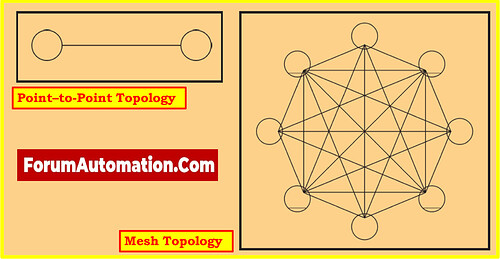- Point-to-Point Topology and Mesh Topology are two distinct network architectures employed in computer networking.
- These topologies differ significantly in terms of their structure, connectivity, scalability, fault tolerance, and implementation.
- The simplest topology is point to point, which consists of just one connection between two devices (Figure).
- In most cases, this is effective in very small systems.
- The configuration gets quite complicated as the installation expands and communication between all of the system’s “participants” is necessary, as seen in Figure. This is typically referred to as a mesh topology.
- As can be seen, there are 56 interfaces needed to link eight users, which equals 28 lines.
- There are an additional 8 lines and 16 interfaces for the ninth user. In terms of hardware and installation, this is obviously incredibly expensive.
Point-to-Point Topology
- Point-to-Point Topology is a network configuration where each device in the network connects directly to a single other device.
- In this setup, every device has a dedicated link or connection to communicate with a specific device.
- This type of topology forms a direct connection or link between two endpoints. Examples of point-to-point connections include Ethernet connections between two computers, serial connections between two devices, or a USB connection between a computer and a printer.
- One of the primary characteristics of point-to-point topology is the one-to-one connectivity between devices.
- Each device has a unique link to communicate with another device, enabling direct and dedicated communication.
- Point-to-Point topology is typically utilized for connecting two devices over short distances, such as in small-scale networks or connections within a single room or office.
Mesh Topology
- Mesh Topology, on the other hand, is a network architecture in which every device is connected to every other device.
- Each device within the network has a dedicated point-to-point link to communicate with every other device, forming a complex interconnection pattern.
- Mesh topology can be further categorized into two types: Full Mesh and Partial Mesh.
Full Mesh topology
- Full Mesh topology, every device has a direct link to every other device, creating a fully connected network.
- This means that the number of connections in a Full Mesh network increases exponentially with the number of devices, resulting in a high number of interconnections.
- Full Mesh topologies are typically employed in small-scale networks or critical systems where high reliability, redundancy, and fault tolerance are paramount.
Partial Mesh topology
- In a Partial Mesh topology, only some devices have direct links to all other devices, while others have links to only a subset of devices.
- This topology reduces the number of connections compared to Full Mesh, which can help manage the complexity and cost of the network while still providing a certain level of redundancy and fault tolerance.
- Partial Mesh topologies are commonly used in larger networks where a full mesh would be impractical or unnecessary.
Differences between Point-to-Point and Mesh Topology
Connectivity
Point-to-Point topology provides one-to-one connectivity, while Mesh topology offers many-to-many connectivity.
Links
In Point-to-Point topology, each device has a dedicated link to a specific device, whereas in Mesh topology, each device has links to multiple other devices.
Scalability
Point-to-Point topology is suitable for small-scale networks, while Mesh topology is often employed in larger networks due to its scalable nature.
Redundancy and Fault Tolerance
Mesh topology provides inherent redundancy and fault tolerance since multiple paths exist for data to travel. Point-to-Point topology lacks built-in redundancy and fault tolerance, as it relies on individual direct connections.
Complexity
Point-to-Point topology is simpler to implement and requires fewer connections compared to Mesh topology, which can become complex as the number of devices increases.
Cost
Point-to-Point topology is generally more cost-effective due to its simpler structure and lower number of connections, while Mesh topology can be more expensive due to the higher number of links required.
